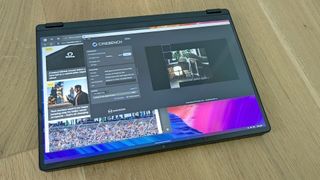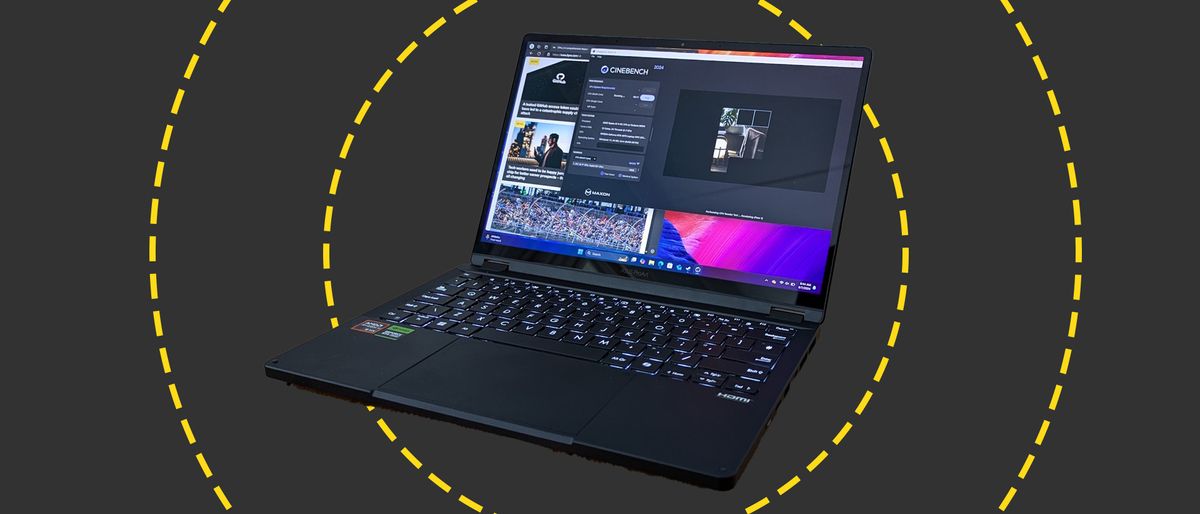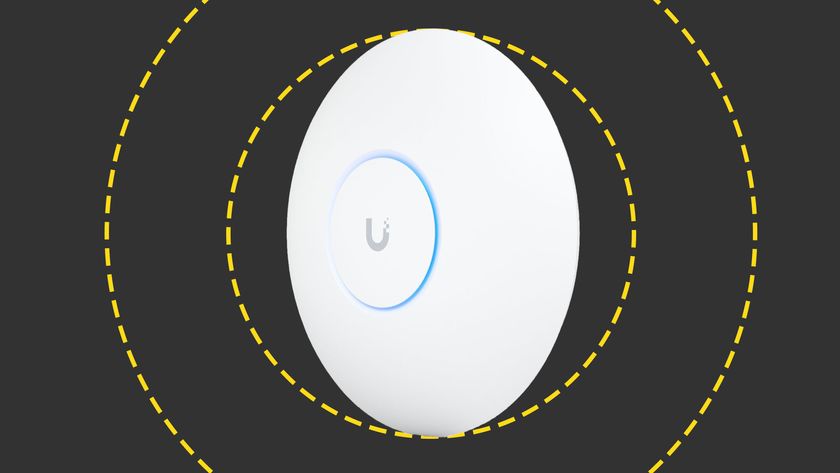IT Pro Verdict
Pros
- +
Small, light and flexible design
- +
Superb OLED screen
- +
Fantastic battery life
- +
Large trackpad and comfortable keyboard
- +
Excellent CPU, GPU and AI performance
Cons
- -
Expensive
With its new 13-inch convertible, Asus seems determined to push the limits of how much creative power you can cram into a small-screen laptop. Despite its diminutive size and low 1.38Kg weight, the ProArt PX13 has the kind of specs you might normally associate with a hulking gaming laptop, including AMD's latest AI-enhanced CPU and a choice of NVIDIA RTX graphics processors. What's more, it surrounds these with must-have features for more demanding business and creative pros, including a 13.3in color accurate OLED screen, an excellent keyboard, and cutting-edge connectivity.
It's not necessarily the sleekest or most stylish ultraportable – though we think it looks great – but it's a real powerhouse that can handle high-end applications and some of the most demanding enterprise tasks.
Asus ProArt PX13: Design
Asus has kept things relatively simple with the ProArt PX13's design. It has a matt-black aluminum shell with just a subtle Asus ProArt logo on the lid and vents on either side, with a further grill occupying most of the bottom. It's tested to US MIL-STD 810H standards and feels extremely tough while providing a flexible 2-in-1 construction, where you can push the screen back all the way past flat so that it sits flat against the base. You can use it in a tablet or tent configuration for use with touch or stylus and Asus even bundles in its own pen with 4096 levels of sensitivity for handwriting, drawing, and annotations.
All the ports and sockets are on the side, with one USB 4 Type-C port, the 3.5mm headphone socket, and an HDMI 2.1 port on the left-hand side, and a second USB 4 Type C port, a microSD card slot and a USB 3.2 Gen 2 port on the right. This is the point where we'd normally complain that there aren't enough Type-C ports as one will be occupied with the charger, but for once we don't need to as the PX13 needs a proprietary DC input for its 200W power supply. This looks a lot like a USB Type-C port, but it's square and taller, and a Type-C plug won't fit.

With all that in place, You won't need a docking station just to connect a basic desktop setup unless you need Ethernet, and with Wi-Fi 7 already onboard that's probably not a big deal. It's good to see the next big Wi-FI standard appearing on high-end laptops, even if you won't have a Wi-Fi 7 network or access point in place for another year or so.
Here's something else that Asus has got right: the keyboard. The large, flat-topped keys feel firm under a light touch but push down easily when pressed, with a respectable 1.7mm of travel. The action is fast and responsive, and the only real grumble about the layout is that it could do with larger left Shift and Ctrl keys, and maybe a full-height, classic-style Enter key. It even has Microsoft's new Copilot key, in case you've worked Redmond's AI tools into your workflows. And though the touchpad's height is slightly truncated by the size of the laptop itself, Asus has maximized the space by having it run from the bottom of the keyboard to nearly the edge of the deck, and by stretching it out to 12.6cm wide. It's sensitive enough for precision work and feels smooth and responsive to the touch.
Asus ProArt PX13: Display
The screen is one of the best we've seen on a laptop of this size, albeit not necessarily the brightest. Asus claims a maximum SDR luminance of 400 nits, reaching 500 nits with HDR content, and in tests, we measured it below that, at 367.5nits. All the same, the 2880 x 1800 resolution means superb levels of clarity and sharp detail, while colors are beautiful and vibrant in a way that hits you from the moment it's turned on.
Those first impressions aren't misleading. Your perfect blacks have the usual infinite contrast of OLED, while in tests we measured 100% coverage of the sRGB gamut, 99.5% of DCI-P3, and 87% of Adobe RGB. The MyAsus utility allows you to quickly tune the screen for near-perfect sRGB or DCI-P3 color accuracy as well, leading to an average Delta-E of just 0.48. It's a fine display for high-end creative work, but just as good if you'd rather stream movies than contribute to their production; 4K HDR content looks great.

Surprisingly, it sounds great too. Asus has pulled off a trick with the PX13's audio, with the output louder, fuller, and richer than it should be from such a compact frame, and with a much wider and more immersive stereo spread to boot. It's also clear and very listenable for video calls and meetings, helped by a 1080p webcam that gives nice, well-balanced, and detailed video. An IR module also adds support for Windows Hello face recognition, making signing in reliable and instant.
Asus ProArt PX13: Performance
The Ryzen AI 9 HX370 is one of AMD's new Strix Point processors, and while it's beaten by Qualcomm's Snapdragon X CPU in some applications and benchmarks, it's arguably a better all-rounder. What's more, it's a little faster in this laptop than in the Asus Zenbook S16 where we saw it first, scoring 2750 (single-core) and 15080 (multi-core) in Geekbench 6, against 2782 and 13508. That multi-core score also puts it ahead of the Asus Vivobook S15 with its Snapdragon X Elite, with 2427 and 14337. In the Maxon Cinebench 24 rendering benchmark, which supports both ARM64 and x86 architectures natively, the PX13 scores 115 (single-threaded) and 1023 (multi-threaded) to the Vivobook S15's 106 and 941.
We can't use our usual PC Mark 10 productivity benchmarks to gauge performance against the Vivobook S15, as the latter won't run it. Still, the score of 7534 compares well with results from Core Ultra 7 and Core Ultra 9-powered machines.

The other advantage Strix Point brings is a significantly faster Radeon 890M integrated GPU. However, that doesn't really weigh in here, because Asus has added an RTX 4070 GPU. This gives you huge amounts of performance for 3D applications, video compositing and rendering, local AI processing, games, and just about everything else. In 3DMark's TimeSpy tests it destroys the Snapdragon X's GPU, scoring 9621 to 1848, then repeats the trick in the new Steel Nomad test, with 2183 to 495.

To cut things short, this is a formidably powerful laptop that just happens to be very compact, and while it's thicker and much noisier than some rivals, it's worth it if you need high levels of performance, particularly in the GPU. And as the Ryzen AI 9 HX370 also features its own 50 TOPs neural processor (NPU), it's a good all-around choice if you want to make the most of any new and emerging AI applications.
With all this power, you might expect mediocre battery life – or worse. However, it's actually very good. Looping video with the brightness set to 170nits, the ProArt PX13 kept going for 13 hours and 52 minutes without running out of juice, and a full working day doesn't phase it at all. The new Snapdragon X Elite laptops can keep going for even longer, but this is still more than good enough for daily use.
Asus ProArt PX13: Is it worth it?
It's not cheap, but we can't think of another laptop that gives you this level of CPU and GPU performance in such a compact, convertible form factor. Whether sitting at the desk, on the move, or slumped on the sofa, it's a joy. If you don't need the portability, larger 16-inch models might give you the same or more power with slightly better ergonomics – and possibly at a cheaper price point - but where the small size matters, the PX12 can't be beaten. It's an exceptional device for power users and creatives on the go.
Asus ProArt PX13 specifications
| Display | 13.3-inch 2,880 x 1,800 OLED, 60Hz refresh rate |
| Processor | AMD Ryzen AI 9 HX 370 |
| GPU | NVIDIA GeForce RTX 4070 8GB |
| RAM | 32GB LPDDR5X |
| Ports | 2x USB 4 Type-C, 1x USB 3.2 Gen 2 Type-A, HDMI 2.1, MicroSD card reader |
| 3.5mm audio jack | Yes |
| Camera | 1080p webcam with IR/Windows Hello |
| Storage | 2TB PCIe4 SSD |
| Connectivity | Wi-Fi 7, Bluetooth v5.4 |
| Weight | 1.38Kg |
| Dimensions | 298.2 x 209.9 x 15.8 to 17.7mm |
| Battery Capacity | 73Wh |
| Operating System | Windows 11 Home |
Stuart has been writing about technology for over 25 years, focusing on PC hardware, enterprise technology, education tech, cloud services and video games. Along the way he’s worked extensively with Windows, MacOS, Linux, Android and Chrome OS devices, and tested everything from laptops to laser printers, graphics cards to gaming headsets.
He’s then written about all this stuff – and more – for outlets, including PC Pro, IT Pro, Expert Reviews and The Sunday Times. He’s also written and edited books on Windows, video games and Scratch programming for younger coders. When he’s not fiddling with tech or playing games, you’ll find him working in the garden, walking, reading or watching films.
You can follow Stuart on Twitter at @SATAndrews.














